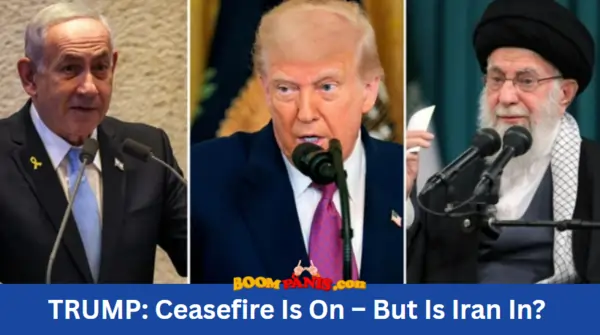Global leaders push for peace as Israel and Iran agree to a ceasefire. Get the latest updates, diplomatic insights, and what this means for the region.

Israel Iran Ceasefire Begins Amid Global Pressure and Fragile Trust
JERUSALEM / TEHRAN, June 25, 2025 — A temporary ceasefire between Israel and Iran came into effect this week, following nearly two weeks of high-intensity conflict and urgent international mediation. Announced on June 23 by former U.S. President Donald Trump, the Israel Iran ceasefire appears to be holding, despite early accusations of violations by both parties.
The ceasefire follows what has been dubbed the “12-Day War,” marked by drone strikes, cyberattacks, and rocket exchanges that drew deep concern across the Middle East and beyond. Although Iran’s government denied that a formal agreement had been signed, it signaled a readiness to pause hostilities—conditional on mutual restraint.
Mixed Messages on Agreement Terms
On Sunday, President Trump stated that both Israel and Iran had accepted his administration’s ceasefire proposal. Israeli Prime Minister Benjamin Netanyahu confirmed Israel’s compliance with the plan, describing it as a strategic step after achieving key military objectives.
However, Iran’s Foreign Minister Abbas Araghchi pushed back, saying, “There is no agreement on a ceasefire yet. We will stop if they stop. But no formal accord has been reached.” The conflicting statements raised doubts about how binding the ceasefire truly is, though ground activity in the following hours showed significant de-escalation from both sides.
Clashes Before Calm
Despite the ceasefire announcement, both nations reportedly exchanged fire before the truce deadline. Iran launched several missiles toward Beersheba on June 24, resulting in civilian casualties. In response, Israel conducted airstrikes targeting a radar facility outside Tehran.
By early June 25, however, military activity appeared to decline significantly. A senior IDF official told reporters that “orders were given to stand down, barring any further aggression from the Iranian side.”
No formal schedule for withdrawal of troops or international monitoring has been released. While some reports suggested the U.N. or Gulf nations may take on verification roles, these claims remain unconfirmed.
Diplomatic Efforts and Regional Reactions
The ceasefire comes after days of shuttle diplomacy led primarily by the United States, with support from Qatar and Oman. The Biden administration reportedly maintained backchannel communications with both Israeli and Iranian leadership, applying economic and diplomatic pressure to reach a temporary halt in fighting.
Saudi Arabia, Egypt, and Turkey welcomed the truce, calling it a “step toward regional stability.” Russia and China echoed these sentiments, offering post-conflict support and humanitarian assistance.
European markets reacted quickly to the news, with oil prices dropping approximately four percent. The decline reflected reduced fears of disruptions to the Strait of Hormuz—a critical route for global energy shipments.
Fragile Ceasefire Faces Major Risks
Despite the temporary calm, analysts warn that the Israel Iran ceasefire remains fragile. Proxy militias in Syria, Iraq, and Lebanon continue to operate, raising the risk of indirect escalations. Both sides retain deep mistrust, especially in the absence of a formal enforcement mechanism or third-party monitors.
Dr. Lina Haddad, a senior analyst at the International Crisis Institute, said, “This ceasefire may stop the missiles—for now—but without ground-level trust and accountability, it could unravel overnight.”
Trump’s comments also added complexity. During a press conference, he criticized both nations for “unnecessary stubbornness,” while urging U.N. leaders to assist in crafting a long-term roadmap for peace.
What’s Next for the Region?
International diplomats are preparing for preliminary talks in Geneva next month, aimed at setting the groundwork for nuclear de-escalation and arms control. However, no date has been officially confirmed by either Israel or Iran.
Humanitarian agencies, including the United Nations and Red Crescent, are preparing to enter conflict-affected areas such as western Iran, Gaza, and northern Israel to deliver aid and assess damage.
In Washington, congressional leaders urged continued diplomatic engagement. Senator Alicia Ramirez said, “We can’t call this a victory—but it’s a pause, and we need to use it wisely.”
Conclusion: A Pause, Not a Peace
The Israel Iran ceasefire signals a potential turning point in an increasingly volatile regional conflict. But it is not a permanent peace accord, and both nations remain on edge. As the world watches, global leaders hope this fragile calm can be leveraged into something lasting—before another spark ignites a wider war.
📚 Sources and References
1. Reuters

Bianca Marie Reyes, aka Tita BoomBi, is a 30-year-old Filipina content creator who turns everyday chika into real talk and real-time news. Known for her witty takes and no-fake-news style, she breaks down viral stories, headlines, and public updates into fun, bite-sized content for the digital Filipino. She’s your online tita, always tuned in and always telling it like it is. With a mix of humour and honesty, she keeps things relevant, relatable, and 100% not fake.
